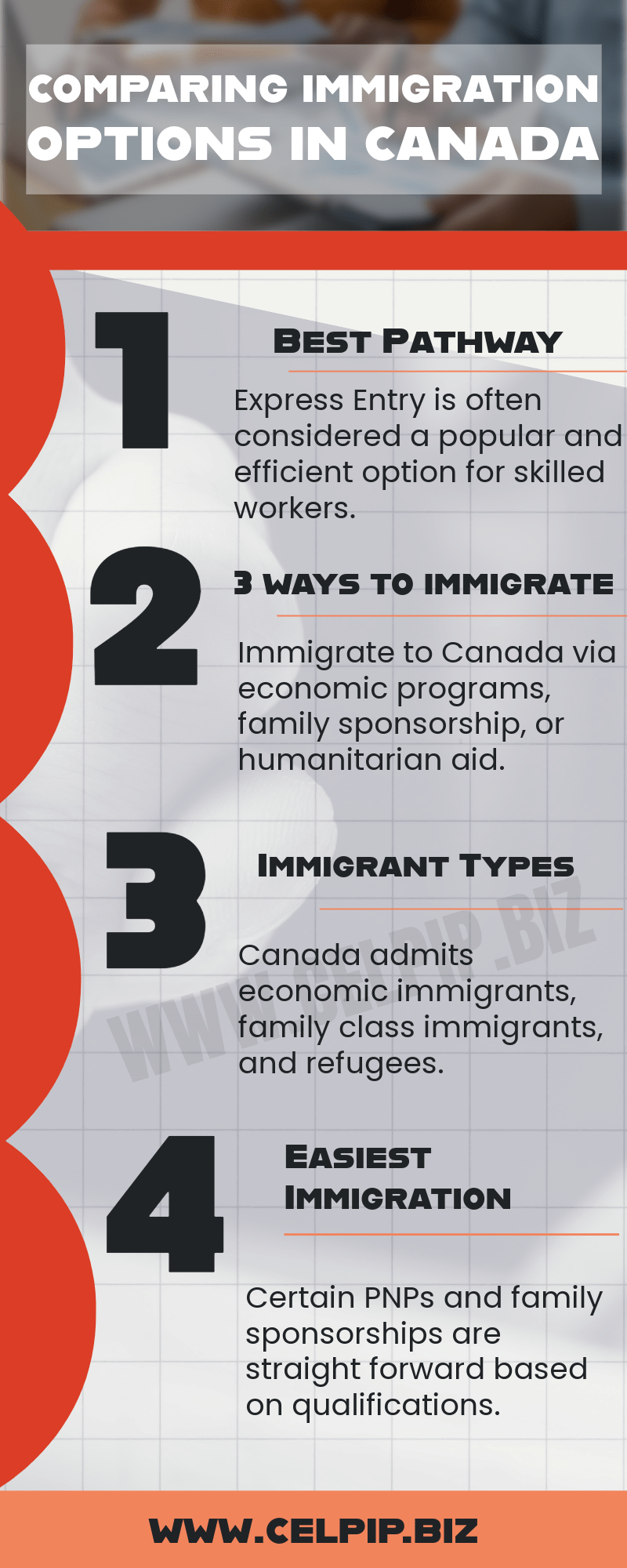Comparing Immigration Options in Canada – Canada has many ways for people to move there. It’s exciting, but it can also be hard to know which way is best for you.
We’re here to help! We’ll compare the different ways you can move to Canada, like finding a job, joining family, or studying.
Our goal is to make it easier for you to understand your options and pick the right one. Whether you want to work, be with family, or study, we’ll guide you through the choices.
Different Immigration Pathways in Canada
Canada offers several immigration pathways, each designed to accommodate various goals, qualifications, and circumstances of prospective immigrants. Here’s an overview of some of the key pathways:
- Express Entry System – This is the primary pathway for skilled workers who want to immigrate to Canada permanently. Under Express Entry, candidates are assessed based on factors like age, education, work experience, and language proficiency in English or French. Eligible candidates are entered into a pool and ranked based on a points system (Comprehensive Ranking System). Those with the highest scores receive an Invitation to Apply (ITA) for permanent residence in regular draws conducted by Immigration, Refugees and Citizenship Canada (IRCC).
- Provincial Nominee Programs (PNPs) – Each Canadian province and territory, except Quebec, has its own PNP that allows them to nominate individuals who wish to immigrate to that specific province or territory. PNPs are often tailored to address the specific labor market needs and demographic priorities of each region. Provincial nominations provide an additional opportunity for skilled workers, entrepreneurs, and sometimes semi-skilled workers to gain permanent residence in Canada.
- Family Sponsorship – This pathway allows Canadian citizens and permanent residents to sponsor family members for immigration to Canada. Eligible relationships for sponsorship include spouses, common-law partners, dependent children, parents, and grandparents. The sponsor must demonstrate the ability to provide financial support and meet other eligibility criteria. Family sponsorship is an essential avenue for reuniting families in Canada.
- Study Permit to Permanent Residence – International students who study in Canada may have the opportunity to transition to permanent residence through various programs. The Post-Graduation Work Permit (PGWP) allows graduates to gain valuable Canadian work experience after completing their studies. They can then apply for permanent residence through pathways like the Canadian Experience Class (CEC) within the Express Entry system or provincial nomination programs designed for graduates.
- Start-up Visa Program – This program is designed for entrepreneurs who have innovative business ideas and the potential to create jobs in Canada. To qualify, applicants must secure a commitment from a designated Canadian venture capital fund, angel investor group, or business incubator. Successful applicants and their immediate family members can obtain permanent residence in Canada.
- Refugee and Asylum Seeker Programs – Canada has a long-standing commitment to providing protection to refugees and asylum seekers fleeing persecution, conflict, or human rights abuses. The country offers various pathways for refugees to seek protection, including resettlement programs, asylum claims made at the border or within Canada, and sponsorship by individuals or groups.
Exploring Economic Opportunities for Immigration
Exploring Economic Opportunities for Immigration to Canada entails several pathways designed to attract skilled workers, entrepreneurs, and investors who can contribute to Canada’s economy and fill labor market needs. Here’s an in-depth look at some of the key economic immigration programs:
- Express Entry System – The Express Entry system is a flagship program for skilled workers who wish to immigrate to Canada permanently. It manages applications for three federal economic immigration programs: the Federal Skilled Worker Program (FSWP), the Federal Skilled Trades Program (FSTP), and the Canadian Experience Class (CEC). Eligible candidates create an online profile and are ranked based on factors such as age, education, work experience, language proficiency, and other adaptability factors. Those with the highest Comprehensive Ranking System (CRS) scores are invited to apply for permanent residence in regular draws conducted by Immigration, Refugees and Citizenship Canada (IRCC).
- Provincial Nominee Programs (PNPs) – Each Canadian province and territory, except Quebec, operates its own PNP to address specific labor market and demographic needs. PNPs allow provinces to nominate individuals who have the skills, education, and work experience needed in their local economies. Provincial nominations provide an additional pathway to permanent residence for skilled workers, semi-skilled workers, entrepreneurs, and sometimes international graduates.
- Atlantic Immigration Pilot Program (AIPP) – The AIPP is a partnership between the Government of Canada and the Atlantic provinces (Nova Scotia, New Brunswick, Newfoundland and Labrador, and Prince Edward Island) aimed at addressing labor market needs in the region. It offers three streams: the Atlantic High-Skilled Program, the Atlantic Intermediate-Skilled Program, and the Atlantic International Graduate Program. Eligible candidates with a job offer from an employer in one of the participating provinces can apply for permanent residence through this pilot program.
- Rural and Northern Immigration Pilot (RNIP) – The RNIP is designed to spread the benefits of economic immigration to smaller communities in rural and northern regions of Canada. It allows participating communities to recommend eligible candidates for permanent residence based on local labor market needs and community ties. Candidates must have a genuine job offer from an employer in a participating community and meet the program’s eligibility criteria to apply for permanent residence.
- Start-up Visa Program – The Start-up Visa Program is for entrepreneurs who have innovative business ideas and the potential to create jobs in Canada. To qualify, applicants must secure a commitment from a designated Canadian venture capital fund, angel investor group, or business incubator. Successful applicants and their immediate family members can obtain permanent residence in Canada.
Educational Pathways to Immigrate to Canada
Educational Pathways to Immigrate to Canada offer avenues for international students to transition from temporary residency to permanent residence after completing their studies.
Canada is renowned for its high-quality education system and is a popular destination for international students seeking to pursue academic and career opportunities:
- Study Permits – International students wishing to study at a designated learning institution (DLI) in Canada must obtain a study permit before beginning their studies. A study permit allows students to stay in Canada for the duration of their program and may also allow them to work part-time on campus during their studies and full-time during scheduled breaks.
- Post-Graduation Work Permit (PGWP) – Upon completing their studies, eligible international graduates may apply for a PGWP, which allows them to gain valuable Canadian work experience. The PGWP is typically issued for a duration of up to three years, depending on the length of the study program. Work experience gained through the PGWP can be valuable for future immigration applications.
- Canadian Experience Class (CEC) – The CEC is a federal immigration program managed through the Express Entry system. It is designed for individuals with skilled work experience gained in Canada. International graduates who have obtained skilled work experience in Canada may be eligible to apply for permanent residence through the CEC, provided they meet the program’s eligibility criteria.
- Provincial Nominee Programs (PNPs) – Some Canadian provinces and territories offer immigration streams specifically tailored to international graduates. These streams allow graduates to apply for provincial nomination, which can enhance their eligibility for permanent residence. Provincial nomination programs for international graduates often have specific criteria related to education, language proficiency, and work experience.
- Express Entry System – International graduates with skilled work experience gained in Canada may also be eligible to enter the Express Entry pool and compete for permanent residence through the Federal Skilled Worker Program (FSWP), the Federal Skilled Trades Program (FSTP), or the Canadian Experience Class (CEC). Education obtained in Canada, along with Canadian work experience, contribute to a candidate’s Comprehensive Ranking System (CRS) score, which determines their ranking in the Express Entry pool.
- Pathways for PhD Graduates – Canada offers special immigration pathways for international graduates with doctoral degrees from Canadian institutions. These pathways recognize the value of advanced education and research contributions and provide opportunities for PhD graduates to obtain permanent residence.
Conclusion
The array of immigration options in Canada reflects the country’s commitment to diversity, talent, and economic growth.
Whether through skilled worker programs like Express Entry, family sponsorship, educational pathways, or entrepreneurial opportunities, Canada offers avenues for individuals and families to build new lives and contribute to the nation’s prosperity.
From the bustling cities to the tranquil rural communities, Canada welcomes newcomers with open arms, fostering a vibrant mosaic of cultures and perspectives.
As you begin your immigration journey, it’s essential to explore the various pathways available, aligning aspirations with the most suitable option.
With careful consideration and determination, Canada stands ready to embrace those seeking new beginnings and opportunities for a brighter future.
Frequently Asked Questions on Immigration Options in Canada
- Which immigration pathway is best in Canada?
Express Entry is often considered a popular and efficient option for skilled workers.
- What are the 3 ways to immigrate to Canada?
The three main ways to immigrate to Canada are through economic immigration programs (such as Express Entry), family sponsorship, and refugee or humanitarian programs.
- What are the 3 types of immigrants admitted to Canada?
Canada admits three main types of immigrants: economic immigrants, family class immigrants (sponsored by a Canadian citizen or permanent resident), and refugees or protected persons.
- Which Canadian immigration is easiest to immigrate?
Many find certain provincial nominee programs (PNPs) or family sponsorship routes relatively straightforward depending on their qualifications and circumstances.
Check out our Web Story on Comparing Immigration Options in Canada.





